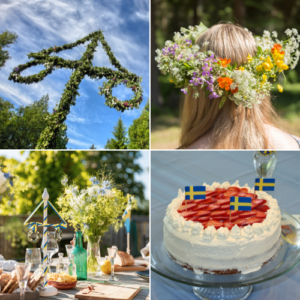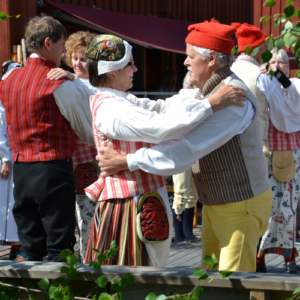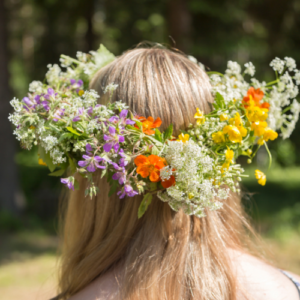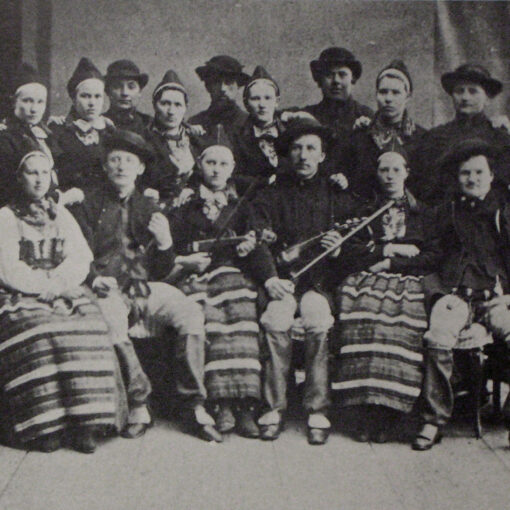Why I never watched the movie Midsommar
Have you seen the movie Midsommar or as it’s called in English Midsummer from July 2019? I have not. And there is a very simple reason for that. Midsummer is one of the holidays that I miss the most from Sweden. When the movie was released, I was of course, very curious about it. But as I read about it I realized that this was a horror movie, depicting a pagan culture with roots in Norse mythology, which is not true.
And after watching a few trailers, I decided that this was not for me. The story does not at all depict what mid-summer is in Sweden. And it was not even filmed in Sweden. It was filmed in Budapest, Hungary. And I am not a fan of horror movies in general. So today I want to share with you what Midsummer really is in Sweden.

What midsummer in Sweden is
Midsummer Eve is celebrated on the Friday of the week between June 19 and June 25. And let’s start to talk about how it is celebrated today. This is the week of the summer solstice in the Northern hemisphere, which is the day with the longest period of daylight. This year, that day will be on June 21st, a Tuesday and the Midsummer Eve will be celebrated on Friday the 24th. In the Northern parts of Sweden, above the Arctics circle, this is the time of the midnight sun, when the sun never sets. Midsummer for many often marks, the beginning of the summer, and many Swedes start their five-week holiday at Midsummer.
There are some things that are obligatory when you celebrate Midsummer in Sweden. First of all, this is a time that you spend with friends and family often in large gatherings. And like so many holidays, it’s filled with food and drink. On the table, you will most certainly find pickled herrings, freshly boiled potatoes, and snaps, a small little glass of alcohol, often Aquavit, and singing. Before you can drink your snaps, you have to sing a snaps visa, a snaps song, and the most common one is called Helan går “all of it goes”, and this is often the initial snaps visa. The first one you sing before you can have any other snaps and I will play an example of Helan går right now.

At almost every dinner table you will find the meat, the potatoes, the vegetables, and at least most of the Midsummer meals end with strawberries. You can have either strawberry with whipped cream or which is very common a strawberry cake usually decorated with whipped cream, strawberries, and little Swedish flags. After all that food singing and drinking, it’s time to start midsummer festivities.
If you go to an official celebration, for example, at Skansen in Stockholm, which is the world’s oldest open-air museum, you might see people wearing the traditional costumes of Sweden. There are a couple of things a Midsummer festivity must have the first one is the maypole, and I will talk a little bit more about what a maypole is when I look at some history of Midsummer, but it is decorated with leaves and flowers.

And flowers are very important for Midsummer. You see a lot of people wearing wreaths of flowers in their hair, both girls and boys, men, and women. When the maypole is raised up then starts the dancing. This is a time where Swedes relax and stop being so conservative and correct.
And you can see men and women, boys, and girls all jumping around the maple, singing the song, små grodorna, little frogs, imitating little frogs, jumping like frogs and doing a lot of different gestures, showing that the frogs don’t have ears and don’t have tails and let’s listen to små grodorna.

There are usually a lot of games. It can be anything from sack running to croquet or to the Swedish game Kubb, which is one of my favorite games. You play in two teams, and the game is about knocking down 10, little wooden blocks on the other team’s side you win by knocking down a large block called the king. This is a game that I have introduced to my family here in the US, and we love to play Kubb.
But what about Midsummer Magic
But as I said, there are some traditions with roots in folklore, not like the movie I talked about in the beginning, with Norse roots, but it has some magic connected to the folklore. The Nordic Midsummer celebration has its roots in Christian traditions that are connected to Saint John, the Baptist, or as he’s called in Swedish, Johannes Döparen.
The earliest Swedish source concerning Saint John, the Baptist celebration stems from 1555, when Olaus Magnus, a Swedish priest, and Catholic Bishop refers to midsummer as the day where people gathered and lit up the night with bonfires (sankthansbål). This is an old tradition first recorded in Europe in the fourth century.
For some reason, Sweden didn’t fancy the bonfires, even though both Norway and Denmark still celebrate with bonfires on the day, that’s called Sankthans. Instead, Sweden imported the tradition of maypole from Germany.

And today, this is the most important symbol for Swedish Midsummer. Sweden developed their own version in the shape of a cross decorated with flower garlands at the end. The Swedish maypole has been discussed as being a phallic symbol, representing fertility, while fertility and hope for a good harvest are tightly connected to Midsummer and the solstice, the maypole should not be interpreted as a phallic symbol, the Swedish maypole should be seen as an adoption of the Christian Cross. The word maypole, or in Swedish majstång, is somewhat misleading since it has very little to do with the month of May. Instead, it refers to the decoration, the Swedish word maja, meaning decorating with leaves in celebration of spring exploding with greenness.
And this is what Midsummer is about celebrating mother nature and her ability to provide a good harvest and thus food on the table for the next year. This was the main reason society prepared for and celebrated Midsummer in the 19th and 20th centuries.
Midsummer was the highlight of the year and the day of joy, love, and coming together with friends, family, and neighbors, dancing around the maypole. Even though Midsummer is a Christian tradition it is also very magical. Swedish Midsummer is a combination of Christian beliefs, as well as supernatural elements from folklore.
For many years, the Swedish church fought hard to keep it in the Christian tradition, but this was a pointless fight and they finally gave up. Some of the magical traditions are, for example, running barefoot or rolling naked in the morning dewy wet grass during Midsummer, this will make you both strong and healthy for the rest of the year, and gathering this morning dew was also important. It was kept and used as a type of medicine alongside the plucking of plants with healing properties as they were considered more potent during Midsummer than any other day of the year. During Midsummer the veil between the worlds of the humans and the supernatural is believed to be almost nonexisting, hidden, magical treasures are said to pop out from the ground, which makes it an excellent night for treasure hunts.

It is also the perfect day to foresee the future. One tradition is that girls should be picking seven different kinds of flowers and lay them under their pillow at night and they will dream of the man they will marry. This picking of the flowers has to be in complete silence otherwise the magic would be broken and the dream lost. Another tradition connected to the number seven and Midsummer night is to jump over seven fences. Through doing this, you could expect to receive both good health and successful harvests for the year ahead. And as I said, you see many people wearing flower wreaths on Midsummer and this tradition was not just started because they are pretty, but also because the flowers were said to be invigorating. The flowers should be saved until Christmas when you put them in your bath to keep you healthy and strong during the winter.

Next week Touristing in Sweden
So there you have it. Midsummer is a combination of Christian and folklore traditions. It is a magical night and it is also an evening when we Swedes start letting loose after a long dark winter. It has very little to do with Norse mythology and pagan cult.
And since it is the beginning of summer for many Swedes, in my next episode I will talk a little bit about vacationing in Sweden, not from a Swedish perspective, but for those of you who are thinking about maybe visiting Sweden from abroad, things that you should think about before you travel to Sweden. Some places I think could be worth visiting and tips and tricks in general for people who are tourists in Sweden. So to make sure you don’t miss that, make sure you subscribe to A Swedish Fika and sign up for my newsletter, which you can find on aswedishfika.com.
Only one thing left to do, and that is to end with the Swedish words that mean goodbye
and that is Hej Då!
Zapraszamy do odwiedzenia strony aikidomazury.pl, sponsorowanej przez nas, gdzie można poznać tajniki aikido i wziąć udział w treningach.





2 thoughts on “Swedish Midsummer”
What great description of celebrating Midsummer. Sadly the tradition has faded a little bit and it’s not how it used to be as I remember growing up. I love the fact that you bring up the Christian tradition of the celebration as Swedes
today seem to forget our Christian roots.
Stay blessed and Hej då!
I have been living in the US since 2002 and I am sure a lot has changed. Thank you for listening 🙂